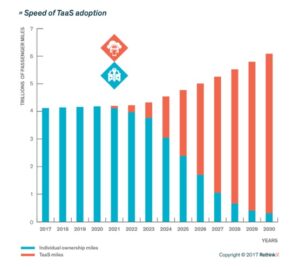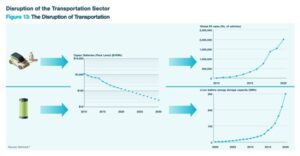Electric vehicles (EV) and autonomous electric vehicles (A-EVs) will create an entirely new business model: Transport-as-a-Service (TaaS). It will disrupt and transform our transportation industries.
If major changes in a number of key technologies come together, we witness a disruption with possible major consequences for our society, according to RethinkX. Such a disruption comes near in five important sectors of our economies: information, food, transport, energy and materials. According to Tony Seba and James Arbib, founders of RethinkX.
RethinkX proposes that disruption of transportation will unfold in two phases. Phase 1: driven by rapid cost reductions, EVs will displace internal combustion engine (ICE) vehicles. Phase 2: in the late 2020s, on-demand autonomous EVs owned by TaaS companies, not individuals, will gain the upper hand.

EV cost reductions
Within a few years, RethinkX suggests, all new vehicles produced will be electric. Because of EV cost reductions, manufacturing of vehicles with internal combustion engines (ICE) will collapse. In the second phase of disruption, autonomous EVs will provide Transport-as-a-Service (TaaS). The date at which this will happen, depends on regulatory approval of autonomous EVs. But in this vision, within 10 years from regulatory approval, 95% of passenger miles travelled will be served by autonomous electric vehicles. These will be not owned by individuals but by fleets, and produce the Transport-as-a-Service model.
This disruption will mean the end of private car ownership. This may be an even bigger change than the simple change of driven to autonomous vehicles. We can look upon the new electric vehicles as taxis driven by ourselves, the renters. RethinkX calls them robo-taxis.
No accidents
Such a change leads to pressing questions. First of all, won’t autonomous vehicles (i.e. without a human being at the wheel) produce many more accidents? RethinkX think not. They give the example of Waymo’s taxi service, that uses a system called autopilot and reached 1 million rider-only miles driven in January 2023. They released statistics that show no reported injuries up to that point. Their taxis do not speed. They don’t get distracted. Therefore, they are safer.
Statistics therefore show that cars with autopilots will save many lives. It may even account for 900,000 lives globally each year, if everyone in the world would drive a car with autopilot. Tesla’s autopilot autonomous electric vehicle (A-EV) is reported to be 8.9 times safer than ordinary cars. Such data may give rise to a stepwise change. For if we take away 90% of accident risk, Transport-as-a-Service may get much more attractive to many people.
 Fundamental change of the transport landscape
Fundamental change of the transport landscape
In short, the advent of robotaxis will mean that transport will be much cheaper – robotaxis will travel 100,000 miles per year instead of a mere 10,000 miles. Facilitated by the much longer lifetime of electric cars. Robotaxis will therefore be more efficient and safer. This will finally mean the end of individual car ownership. When it is much cheaper to let yourself be driven by a robotaxi, people may dump their private cars. This will fundamentally change the transportation landscape. And this disruption will reshape the world’s energy economy.
At a certain point, the introduction of AVs will set in motion a scramble to be one of the companies offering the new service – in expectation of the outsized rewards of market and network opportunities. Once this competition is set in motion, companies will try to be among the first. As RethinkX writes: ‘winners-take-all dynamics will force providers to make large up-front investments to provide the highest possible level of service, ensuring supply matches demand in each geographic market they enter.’ From then onwards, competition and cost will drive and accelerate the adoption of Transport-as-a-Service.
Competition
In this first stage therefore, competition will be fierce. Companies will offer services at a price trending toward cost. This will be made possible by the much lower maintenance costs for electric vehicles. Vehicles may be used 10x as much, have a 500,000-mile lifetime, and have lower costs for maintenance, energy, finance and insurance. RethinkX predicts that Transport-as-a-Service will be four to ten times cheaper per mile than using a new car.
Transport-as-a-Service will be much stimulated by benefits from the electric car.
- Maintenance costs are lower, as are energy, finance and insurance costs Mainly because of reduced friction, heat and vibration
- Cheaper transportation costs because of better utilization
- More intense competition among the few remaining car manufacturers.
On the other hand, the oil and gas industry will be hit hard. Electric Transport-as-a-Service will disrupt oil and gas chains. On the one hand, it will destroy trillions of dollars in investor value; but it will also create trillions of dollars in new business opportunities.
Effects
RethinkX expects that the new Transport-as-a-Service transport system will reduce personal transport energy demand by 80% and reduce emissions by over 90%. It will dramatically reduce air pollution and greenhouse gases from the transport sector, and improve public health. Much of the energy needed may come from solar and wind energy, thereby producing a largely carbon-free road transportation system.
And what about public transport, one might ask. RethinkX expects that Transport-as-a-Service will be cheaper and more convenient than most public transport. Therefore, the distinction between the two may disappear. They even foresee almost free TaaS transport; the costs may be covered by other revenue sources – advertising, data monetization, entertainment or product sales.
Economic consequences
The economic consequences of such a change may be staggering. Shifting toward a TaaS system may save the average American $7100 the per year. This would increase the median household income by almost 10%; and keep an additional $1 trillion per year in Americans’ pockets. Potentially the largest infusion of consumer spending in history.
Moreover, the new system may have major benefits on top of that: increased mobility, less traffic accidents and deaths, less congestion and more efficient use of vehicles and space. Productivity may have a boost because of time savings. People now excluded from transport may enjoy it again. Vast tracts of land in cities will be freed because there will be less vehicles, and therefore less need for parking space. On the other hand, there may be major job losses in conventional energy and transportation industries. The reduced number of cars produced may impact car dealers, and maintenance and insurance companies. And there will be job losses in the oil and gas industries as well.
Barriers to implementation
RethinkX predicts that there will not be any major barriers to implementation. Consumers can try TaaS easily and increase usage as they become more comfortable with it. Yes, in suburban and rural areas wait times and cost might be slightly higher; but still, adoption may be high because people will save money by making use of the service. Disruption, according to RethinkX, will therefore be very fast and extensive. And as people become accustomed to the new service, change might even go faster. On top of that, decision makers can accelerate the speed of adoption by removing barriers; for instance by assigning special lanes to AV vehicles.
Already, RethinkX stresses, the operating cost of electric vehicles is lower than that of vehicles with an internal combustion engine. Their initial costs are also rapidly approaching parity. And because electric vehicles require much less maintenance, they can be in service most of the day – the cost per mile of transport will be much lower. On top of this will come the service and ease of autonomous technology, in which the car will drive itself. Once this is approved, RethinkX predicts a cost-per-mile 10 times cheaper than a contemporary privately owned vehicle.
Reduction of the number of cars
At a certain point in time, people will therefore stop owning a vehicle. They will choose for access to publicly owned, often smaller vehicles that they can use when needed. This will dramatically reduce the number of cars in existence; and it may also reduce the number of cars on the road. Private vehicle ownership will cease to be the prevailing model.
RethinkX even predicts major effects on aircraft transport, particularly over short distances. People will prefer overnight trips in their autonomous electric vehicles, they presume. Aso, they predict a large drop in shipping services. The largest freight categories, like crude oil, oil products, coal, natural gas, iron ore, steel, automobiles, grain and livestock, will all be affected by the changes to come. And of course, also ships will be electrified.
Conclusion
If we take a second look at this package – won’t there be factors to the contrary? The privately owned motor car has almost become an article of faith in our times Will people let go of this holy cow, and adopt a general service? It may smell different, perhaps because some people smoke in their cars. We have never tested the adherence to the privately owned vehicle – this will be an interesting experiment.
Also conspicuously absent from RethinkX’s picture of the future is public transport. Particularly in major cities, this is not a luxury item but a requirement for cities to remain alive. No other transport mode has the capacity to transport many people to a small area and back again. What will RethinkX’s project mean for public transport? Two important questions that have not been answered so far.
Last but not least: we may have a typical Western European view on these developments. For the future of transport, it may be more important to look what is going to happen in emerging economies: China, Japan, India, Africa. There are a lot of opportunities out there!
Interesting? Then also read:
Transport as a Service
The RethinkX project
RMI: decarbonize fast and profitably
